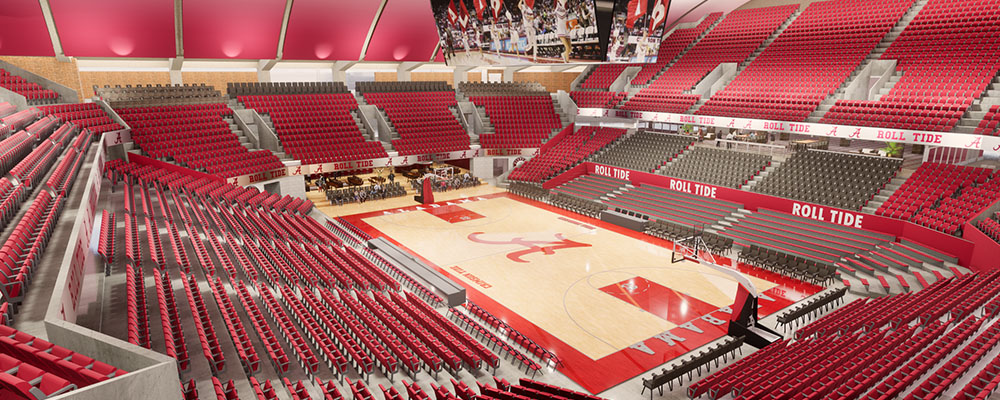In recent years, the University of Alabama has been at the forefront of enhancing its athletic programs, with a particular focus on facilities that enhance player development, team dynamics, and recruitment. With basketball’s prominence on the rise, the construction of a state-of-the-art basketball practice facility was always going to be a crucial step for the program. However, a recent update to the project’s budget revealed a nearly $5 million reduction in its price tag, prompting questions about how such savings were achieved and what it means for the program moving forward.
The new basketball facility, originally projected to cost in the ballpark of $100 million, now carries a much lower price tag. This change wasn’t a result of scaling back the project’s overall vision or abandoning core components of the design. Instead, it reflects a meticulous rethinking of how best to approach a high-budget construction project, ensuring that Alabama’s basketball program still receives the best possible facility while saving millions in the process. Let’s explore the factors that contributed to this drop in cost and the implications it has for both the university and its athletic department.
A Quick Recap: The Original Vision for the Facility
The proposed basketball practice facility was designed to serve as a hub for both the men’s and women’s basketball programs. Featuring multiple full-sized courts, dedicated spaces for strength and conditioning, advanced medical and recovery areas, as well as spaces for player development, video analysis, and team meetings, the original design was conceived to match the high standards of Alabama’s basketball ambitions.
In addition to improving the quality of training and development, the facility was intended to bolster recruiting efforts. In college basketball, top-tier facilities often play a significant role in attracting the best talent, and the vision for Alabama’s practice complex was to create a world-class environment that would set the program apart from other top basketball schools.
The original proposal came with an estimated price tag of approximately $100 million. Given the high expectations and the scope of the project, the funding was viewed as an investment in the long-term success of Alabama basketball. But as plans evolved, so did the realization that efficiencies could be gained and costs reduced, without compromising the facility’s functionality or its impact on the basketball program.
Streamlining the Design: A More Efficient Approach
One of the key factors behind the near $5 million savings is the decision to streamline the design of the facility. Initially, the project aimed to create a facility that was not just functional but also visually stunning—designed to be a centerpiece of Alabama’s athletic infrastructure. While this vision was compelling, it became clear that certain aspects of the design could be simplified without losing the essence of the project.
- Reduced Architectural Complexity
The original design for the basketball practice facility was ambitious, with intricate architectural features and a grand exterior that aimed to make a bold statement. However, the complexity of these design elements led to increased construction costs. Things like custom stone facades, intricate glasswork, and high-end finishes for certain areas contributed to the projected cost.
In the revised proposal, these elements were pared back in favor of a more functional, yet still aesthetically pleasing design. Instead of focusing on excessive luxury or grandeur, the updated design emphasized practicality and durability, which allowed for significant savings in both material and labor costs. The use of simpler, cost-effective materials such as steel and prefabricated elements was introduced, reducing the need for custom work and making the construction process more straightforward.
- Prioritizing Function Over Aesthetics
While the original concept for the facility was centered around creating a statement building—an eye-catching design to match the ambitions of the program—the revised design placed greater emphasis on the actual functionality of the space. Alabama’s basketball programs needed a facility that optimized player development, rather than one built around high-end features that might have gone underutilized.
As part of the redesign, non-essential luxury components, such as grandiose lounges or oversized social areas, were removed. Instead, the focus shifted to expanding the most essential elements: practice courts, training spaces, strength and conditioning areas, and medical facilities. While these changes may have reduced some of the visual grandeur of the building, they helped bring the costs down considerably.
- Reconfiguration of Internal Layout
The interior layout of the facility was also subject to redesign in order to maximize the use of space while minimizing unused square footage. The original plans allocated significant space for auxiliary features, such as large break rooms or unoccupied areas. The updated design aimed to make each square foot functional, reconfiguring these spaces to be multi-use and more aligned with the program’s needs. This reduction in excess space allowed for a reduction in the total square footage required for the project, and therefore, a decrease in overall costs.
By ensuring that all areas of the building had a clear and direct function, the project became more focused and cost-effective, while still offering the best environment for player development.
Improved Project Management: Streamlined Construction Methods
In addition to changes in the design, another significant factor contributing to the $5 million savings was the adoption of more efficient construction techniques and project management strategies.
- Use of Prefabrication and Modular Construction
One of the most effective ways to lower costs in construction projects is the use of prefabricated and modular building techniques. These methods allow for certain parts of the facility to be built off-site and then assembled quickly on location, reducing the overall timeline and lowering labor costs. The use of prefabricated components can also lead to fewer delays and construction errors, as the process is more controlled and streamlined.
For the Alabama basketball facility, the project managers opted to incorporate prefabricated structural components, such as walls, roofing systems, and even portions of the interior spaces, into the construction plan. This change not only helped reduce labor costs but also ensured that the facility could be completed more quickly—allowing the basketball teams to begin using the space as soon as possible without the delay of a lengthy construction process.
- Negotiating with Contractors and Suppliers
The overall construction cost can be significantly impacted by negotiations with contractors, suppliers, and vendors. The project team at Alabama worked diligently to secure competitive bids and ensure that materials were purchased at the best possible prices. By leveraging relationships with trusted vendors and negotiating bulk purchasing deals for certain materials, the cost of construction was further reduced.
Additionally, strategic changes in the schedule allowed for more efficient use of labor and resources, reducing downtime and unnecessary costs. This hands-on approach to project management and cost control helped trim the budget while keeping the integrity of the facility intact.
Focus on Sustainability: Long-Term Cost Savings
An important aspect of the updated design was the inclusion of energy-efficient features and sustainable construction practices. These choices not only benefited the environment but also contributed to long-term cost savings that will continue after the facility is completed.
- Energy-Efficient Systems
The inclusion of energy-efficient systems, such as LED lighting, high-performance HVAC units, and smart building controls, allowed for significant cost reductions in both construction and future operating expenses. These systems will help reduce the facility’s overall energy consumption, leading to lower utility bills over the long term.
For a high-profile project like the Alabama basketball practice facility, the inclusion of these sustainable features made both environmental and financial sense. Energy-efficient systems are expected to significantly reduce operating costs over the life of the building, allowing the athletics department to reinvest savings into other areas of the program.
- Use of Green Building Materials
In line with the sustainability theme, the design team also focused on using green building materials that are not only environmentally friendly but also cost-effective. The use of recycled or locally sourced materials, such as reclaimed wood, eco-friendly insulation, and low-impact finishes, helped reduce material costs and supported the university’s commitment to sustainability.
By making these choices, the facility is expected to achieve long-term operational efficiency, while also enhancing the university’s reputation for environmentally conscious decision-making.
The Broader Impact: Implications for Alabama Basketball
While the near $5 million savings is a significant achievement in and of itself, the real impact of these changes is felt by the Alabama basketball program. The revised cost structure allows the athletic department to allocate resources more efficiently, ensuring that the basketball program receives the resources it needs for player development, recruiting, and success on the court.
The savings also provide the university with more flexibility in managing its budget, allowing for future investments in areas such as scholarships, travel, and staffing. These adjustments, while modest on their own, could have far-reaching implications for the program’s competitiveness, both on the recruiting trail and in terms of overall performance.
A Lesson in Efficiency and Strategic Planning
Alabama’s decision to revise the price tag of its new basketball practice facility by nearly $5 million serves as an example of how large-scale projects can be executed more efficiently without compromising their goals. By focusing on function over luxury, employing modern construction techniques, and incorporating sustainability measures, the university has created a facility that will serve the needs of its basketball programs for years to come while also being mindful of its financial obligations.
This cost-saving measure doesn’t just reflect a reduction in expenses—it’s a strategic decision that positions Alabama to continue excelling in basketball while making wise financial choices. The updated facility will be an asset to both the men’s and women’s teams, supporting player development and recruitment for years to come, while also exemplifying the university’s ability to execute ambitious projects in a cost-effective manner. In the end, Alabama’s new basketball practice facility will stand as a testament to the power of thoughtful planning, strategic adjustments, and fiscal responsibility.



